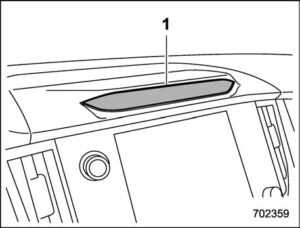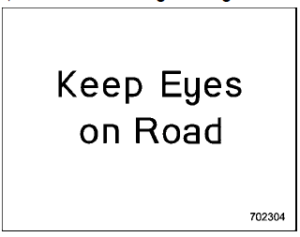 Subaru Legacy 2023 Driver Monitoring System (If Equipped) Touring XT
Subaru Legacy 2023 Driver Monitoring System (If Equipped) Touring XT
Reverse Automatic Braking (RAB), a cutting-edge safety device intended to improve protection while reversing, is standard on the 2023 Subaru Legacy. This technology uses sensors around the back of the car to identify possible obstructions. If it senses an impending accident, it immediately applies the brakes to stop or lessen the impact. Designed primarily for low-speed situations like parking or reversing in confined spaces, the RAB system adds a crucial layer of safety by alerting the driver both visually and audibly before using the brakes. This function, which is a part of Subaru’s extensive array of driver-assist technologies, demonstrates the brand’s dedication to safety and driver confidence, especially in difficult or crowded driving situations.
2024 Subaru Legacy Specs, Price, Features, Mileage (Brochure)
Driver Monitoring System (If Equipped)
Driver Monitoring System is introduced as DriverFocus in some countries. The Driver Monitoring System monitors possible cases when the driver is not paying attention to the forward direction, and also recognizes individual users. This system warns the driver of inattentive/drowsy driving and can support safe and comfortable driving by automatically retrieving the following settings.
- Driver’s position
- Climate control setting
- Meter setting
- Center information display setting
- When a user is registered, various settings are automatically retrieved when the user enters the vehicle.

Camera
CAUTION
- Always use the utmost care in driving
- Overconfidence because you are driving a vehicle with the Driver Monitoring System could easily lead to a serious accident.
- This system cannot detect if the driver is feeling drowsy or is concentrating on safe driving.
- It cannot judge if the driver is awake or asleep if their driving abilities have diminished, or if they are concentrating on safe driving.
- In some circumstances, the system may not be able to correctly detect the driver’s state.
NOTE
- The user recognition camera does not save images, audio, or video.
- The Driver Monitoring System may not operate correctly when sunlight is shining into the vehicle in the following ways.
- Sunlight is shining directly (or through glass) onto the user recognition camera.
- There are shadows on the driver’s face caused by sunlight (or any light with a strong infrared component).
- There are large momentary fluctuations in the strength of the sunlight (or any light with a strong infrared component) shining on the face.
- Correct detection may not be possible when a device that includes an infrared light source (such as a commercially available Driver Monitoring System) is installed in the vehicle interior.
- The Driver Monitoring System may not operate correctly at the following times when the driver is wearing glasses or sunglasses.– The sunglasses do not allow the easy passage of infrared light.
- The surrounding scenery is reflected strongly in the lenses of the glasses or sunglasses.
- The eyes are hidden by the frame of the glasses and the user recognition camera cannot detect the eyes.
- The light from an infrared light source (LED) is reflected in the lenses of the glasses or sunglasses.
- The driver is wearing an eye patch.
- The driver is wearing a hat set deeply over the eyes.
- Depending on the type of mask, correct detection of inattentive/drowsy driving may not be possible.
- Correct user recognition is not possible if the eyes, nose, or mouth is covered with a mask, muffler, sunglasses, or other item.
- The Driver Monitoring System may not operate correctly when the eyebrows, eyes, nose, or mouth are hidden due to an item that is between the face and the system.
- If a thick cover is attached to the steering wheel, then depending on the position set for the tilt/telescopic steering wheel, the cover may block the system’s view of the face, and the system and Driver Monitoring System may not operate correctly.
- Do not attach any stickers to the user recognition camera or the infrared light source (LED). If the user recognition camera or infrared light source (LED) is covered by an obstruction, it will not be possible to correctly monitor the driver.
- If an accessory is hung from the inside mirror, correct detection may not be possible.
- Do not touch the user recognition camera or the infrared light source (LED) directly with your fingers. If there is dirt or a fingerprint on these parts, it will not be possible to correctly monitor the driver. If there is dirt or a fingerprint on these parts, either wipe them with a soft dry cloth or wipe gently with a damp cloth after first firmly wringing the water out.
- If the surface of the user recognition camera or the infrared light source (LED) becomes scratched, correct detection may not be possible. Be careful that hard objects do not contact these parts.
- If there is condensation on the user recognition camera or the infrared light source (LED), correct detection may not be possible. If there is condensation on these parts, wipe it away with a soft dry cloth.
- When registering a user for user recognition, avoid closing your eyes as much as possible.
- If the user recognition success rate is low, it is possible that the user is not correctly registered. Delete the registered data and perform registration again.
- If a user frequently drives both with glasses and contact lenses, it is recommended that registration be performed both when wearing glasses and when wearing contact lenses.
- User recognition starts immediately after entering the vehicle, however, if the user looks downward or at the driver-side mirror for a long time, the user may not be recognized.
- When one person among twins or another pair of persons with similar facial features is registered, the other person may be incorrectly recognized as the registered user when entering the vehicle.
- If the person in the passenger’s seat leans into the driver’s seat, or in other cases when there are two or more faces near the driver’s seat, the system may not operate correctly.
- There are cases when the system concludes that the user’s eyes are closed when the user is looking downward while driving, such as when checking instruments or the navigation screen. In such cases, the drowsy driving warning buzzer may sound or the system may otherwise not operate correctly.
- If the eyes are narrowed when laughing or when there is a dazzling outside light, the system may judge that the eyes are closed and the drowsy driving warning buzzer may sound or the system may otherwise not operate correctly.
- The drowsy driving or asleep warning states are recognized from the length of time and percentage of time that the eyes are closed. The drowsy driving warning buzzer will not sound simply when the driver feels sleepy or yawns.
- Even when the driver does not feel sleepy, if his or her eyes are closed or if he or she blinks frequently, the drowsy driving warning buzzer may sound.
- The inattentive driving warning buzzer may sound if the driver leans forward or puts his or her head out of the window while driving.
- The inattentive driving warning buzzer will not sound when the vehicle is stopped or traveling at slow speed even if the driver is not looking ahead.
- The Driver Monitoring System collects and stores data regarding drivers’ facial features. Facial recognition data is stored locally and does not leave the vehicle. It is not transmitted to or stored by SUBARU or anyone else. The Driver Monitoring System may be disabled and any stored driver data may be deleted by following the instructions below. If the Driver Monitoring System is disabled, it will be unable to provide any of its safety or convenience functions.
The functions that are available vary depending on the Driver Monitoring System setting and the user recognition function setting.
Available functions
| Driver Monitoring System*1 | ||||
| ON | OFF | |||
|
User recognition function*2 |
ON |
Inattentive/drowsy driving warning | Available | Not available |
| User recognition function | Available | Not available | ||
|
OFF |
Inattentive/drowsy driving warning | Available | Not available | |
| User recognition function | Not available | Not available | ||
Available function items
| Driver Monitoring System*1 | ||||
| ON | OFF | |||
|
User recognition function*2 |
ON |
Register User | Available | Not available |
| Delete User | Available | Not available | ||
| Delete All Users | Available | Not available | ||
| Update Seat and Mirror Position | Available | Not available | ||
| Delete Driver Position | Available | Not available | ||
|
OFF |
Register User | Not available | Not available | |
| Delete User | Available | Not available | ||
| Delete All Users | Available | Not available | ||
| Update Seat and Mirror Position | Not available | Not available | ||
| Delete Driver Position | Not available | Not available | ||
- The system can be turned ON/OFF with the center information display.
- The function can be turned ON/OFF in the center information display customization settings. The functions which are available vary depending on whether or not the user is registered.
Available functions
| The user is registered. | The user is not registered. | |
| User recognition function | Available | Not available |
User Recognition Function
- Perform registration, retrieving, or deletion of the seat position and outside mirror angle before beginning driving. There is the risk of an accident if registration, retrieving, or deletion is performed while driving. When a user is registered, it is possible to retrieve the following settings.
- The combination meter display (color LCD) basic screen Displays the screen that the user had selected at the time when he/she last exited the vehicle.
Center information display personalization
- Center information displays basic screen Displays the screen which the user had selected at the time when he/she last exited the vehicle.
- The fuel consumption screen Displays the average fuel economy for past driving by that user.
Climate control personalization
Climate control settings
Retrieves the preferred interior temperature, airflow mode selection, and other settings that the user had selected at the time when he/she last exited the vehicle.
NOTE
When a recognized user exits the vehicle while the Max A/C mode is on and the push engine switch is turned off, the system stores the setting configured before the Max A/C mode was turned on.
Driver Monitoring System ON/OFF status
Retrieves the Driver Monitoring System ON/OFF status which the user had selected at the time when he/she last exited the vehicle.
Changing the personalization settings
| Item | ||
|
Driver’s position personalization |
Seat position/outside mirror angle | Change the setting by using the center information display customization function. |
| Reverse tilt-down outside mirror angle | ||
| Meter personalization* | Combination meter display (color LCD) basic screen |
When the customization screen linked with the synchronized user function is selected and the setting is changed, it is automatically stored. |
| Center information display personalization* | Center information display basic screen | |
| Driver Monitoring System ON/OFF status | ||
- When the Driver Monitoring System is OFF, the Driver Monitoring System continues to store the conditions from immediately before the Driver Monitoring System was turned OFF even if the screen was selected and the setting was changed.
Inattentive/Drowsy Driving Warning
While driving, the Driver Monitoring System monitors possible cases of driver inattention or drowsiness and warns the driver. When the inattentive/drowsy driving warning activates, the buzzer sounds and an interrupt display appears.
NOTE
- The inattentive/drowsy driving warning operates regardless of the status of the user recognition function.
- The inattentive driving warning does not activate when the turn signal is operating or when the select lever is in the “R” position.
- warning activates at the same time as usual even when a vehicle ahead or an obstacle is detected. For details about the EyeSight system, refer to the Owner’s Manual Supplement for the EyeSight system.
Inattentive driving warning
When the system monitors that the driver may be inattentive, it warns the driver. When the inattentive driving warning activates, the buzzer sounds and an interrupt display appears on the combination meter display (color LCD). When the EyeSight system has detected a vehicle ahead or an obstacle in the forward direction, the inattentive driving warning may activate at an earlier time than usual. Refer to the Owner’s Manual Supplement for the EyeSight system.
Drowsy driving warning
Possible drowsiness is detected from the amount of driver eyelid closure, and a warning is given to the driver. When the drowsy driving warning activates, the buzzer sounds and an interrupt display appears.
| Combination meter display (color LCD) | Center information display | Warning chime | |
|
Drowsy driving |
Beep, beep… (Continues until the driver’s eyes open.) | ||
| Very drowsy | Beep, beep, beep, beep, beep (5 times) | ||
|
Slightly drowsy |
— |
Beep |
|
| Not drowsy | — | — | — |
FAQ
What is the Driver Monitoring System in the 2023 Subaru Legacy?
DMS is a technology designed to monitor driver attention and alertness to enhance safety.
How does the system monitor the driver?
It uses a camera and sensors to track the driver’s eye movement and head position.
What happens if the system detects driver distraction?
The system alerts the driver with visual and audible warnings to regain their attention.
Can DMS recognize different drivers and adjust settings accordingly?
Yes, it can recognize registered drivers and automatically adjust seat positions, climate controls, and other personalized settings.
Is DMS active all the time while driving?
It is typically active whenever the vehicle is in motion, monitoring the driver continuously.
How does the system contribute to overall vehicle safety?
By monitoring driver alertness, it helps prevent accidents caused by distraction or drowsiness.
Does the DMS work in conjunction with other safety systems?
Yes, it integrates with other safety features like lane departure warning and adaptive cruise control for comprehensive safety management.
What kind of alerts does the DMS provide?
It provides audible beeps and visual warnings on the dashboard or infotainment screen.
Can the DMS function be turned off by the driver?
Yes, drivers can deactivate the system if they choose, typically through vehicle settings.
How does DMS handle privacy concerns?
The system is designed with privacy in mind, processing data locally without storing images or sending them externally.
Is DMS effective at night or in low-light conditions?
The system is designed to work in a variety of lighting conditions, including at night.
Does DMS adjust its sensitivity based on driving conditions?
It maintains consistent monitoring but may adjust alerts based on driving conditions and speed.
How does DMS assist in long drives or highway travel?
On long drives, it helps in maintaining driver alertness, reducing the risk of accidents due to fatigue.
What maintenance does the DMS require?
It requires minimal maintenance, mainly ensuring the camera and sensors are clean and unobstructed.
Can DMS detect and respond to medical emergencies?
While it can detect unusual driver behavior, it’s not specifically designed for medical emergency response.
Useful Link
View Full User Guide: Subaru Legacy 2023 Touring XT User Guide
Download Manuals: https://www.subaru.com/owners/vehicle-resources/manuals.html
2024 Subaru Legacy Specs, Price, Features, Mileage (Brochure)

